1965 South African Grand Prix race report: Clark peerless at season opener
Despite the intervention of some final lap chequered-flag shenanigans, Jim Clark leads from start to finish to win the new season's first round
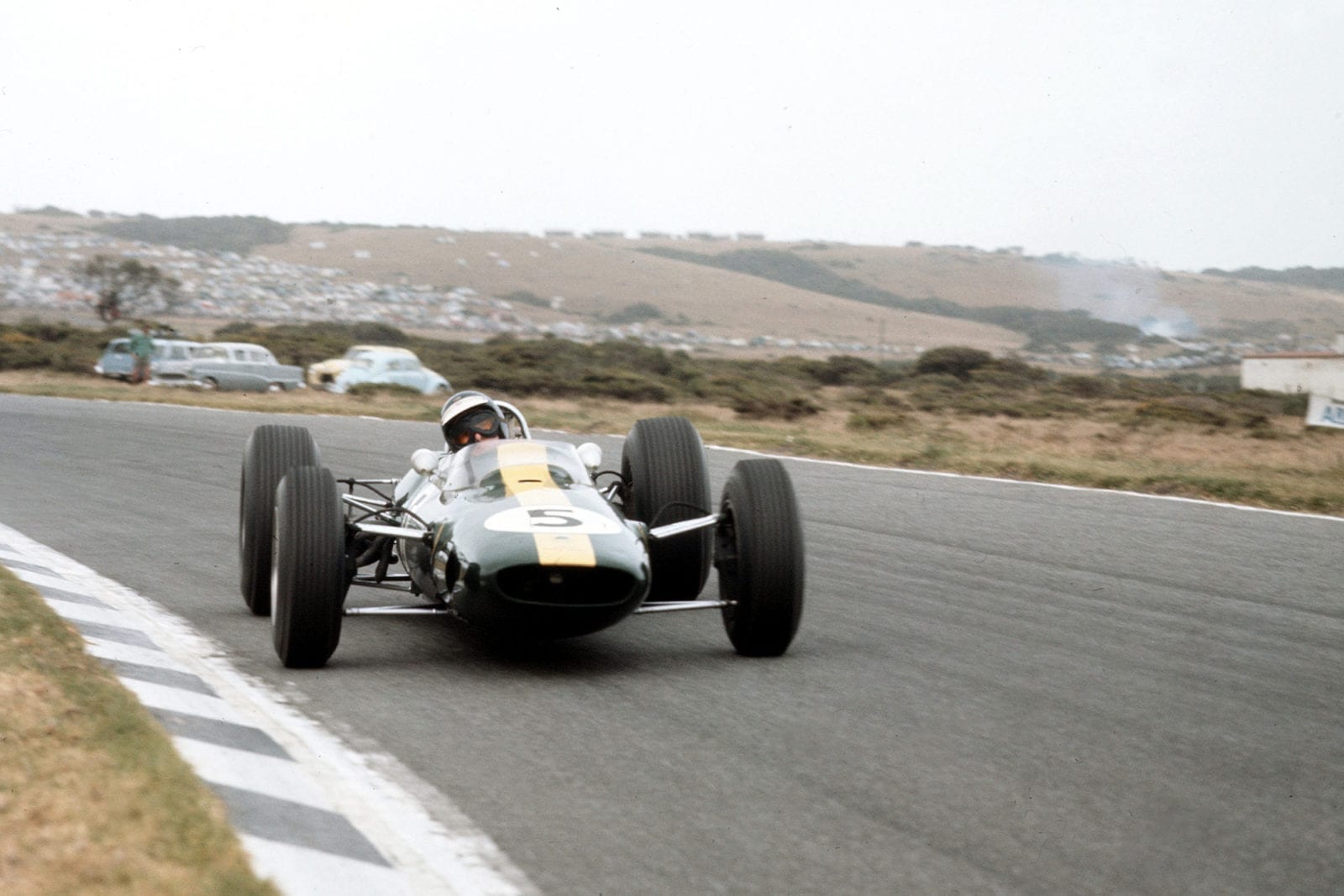
Clark began the season with a dominant win
Motorsport Images
By moving the date of the South African Grand Prix forward by one week, the race became the first Championship Event for 1965 instead of the last event of 1964. This meant that there was no South African Grand Prix for 1964. The race was held as in previous years over 85 laps of the East London circuit which is just outside the town and lies along the side of the sea.
The entry was the best to date, with sixteen invited starters and nine entrants fighting for the last four places. These nine were selected from fourteen entries which had to better 1min 37sec at an informal practice the day before official practice began, but times at this session meant nothing in terms of grid positions.
Ferrari had two cars for Surtees and Bandini. The former was driving a V8, while the Italian drove a flat-twelve. It was nice to see the two cars back in the proper colour, and the entry was in Dragoni’s name, Enzo Ferrari still not having his own competition licence. In the BRM team Graham Hill had a new teammate, Jackie Stewart, the young Scot, being entered for his first Grande Epreuve. Three cars had come down from Bourne, a new car for Stewart basically the same as the car used by Hill at Mexico, Hill’s car being unaltered since the Mexican race. As a spare, there was one of the old cars, in case of accident. Chapman had two cars for Clark and Spence. Clark’s car is being called a 33B, now that the exhaust pipes come through between the top and bottom wishbones, and both cars were as used at Mexico.
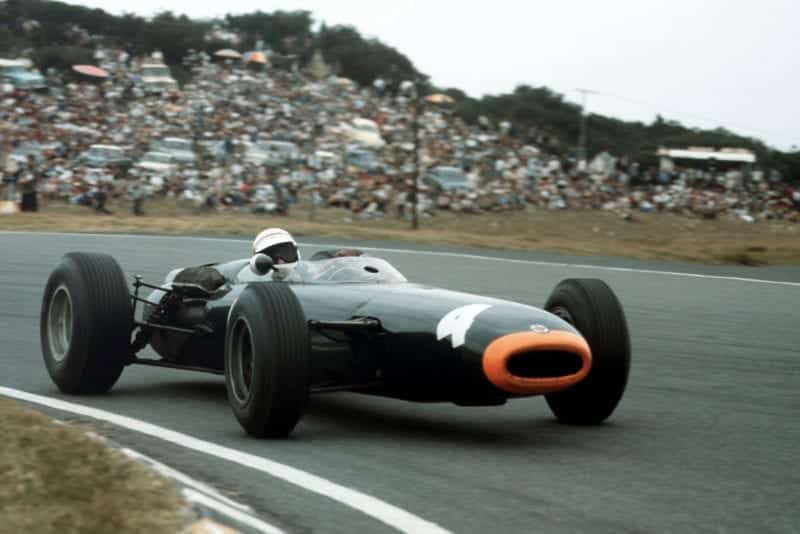
BRM gave a debut to rookie Jack Stewart
Motorsport Images
Two Brabhams for constructor-driver Jack Brabham and his No 1 driver, Gurney, were now the same. Gurney had a brand new car which was almost the same as Brabham’s. A difference of opinion had developed between the two drivers over which tyres they were to use. Gurney wanted Goodyear, whilst Brabham wanted the faster Dunlops, so when the cars went out to the first practice they were, in fact, on different tyres.
John Cooper’s No 2 driver, like BRM’s was new to F1 racing. Jochen Rindt was racing in only his second Grand Prix, the first being at Zeltweg in Rob Walker’s spare car. McLaren was still Cooper’s No 1 driver, and both cars were very little altered. By using rear wheel castings on the front Coopers had widened the front track by 3in which helped with stability.
The Rob Walker racing team will now be making two entries everywhere, with Bonnier driving the Brabham-Climax and Siffert driving a Brabham-BRM, both cars in the Walker dark blue. Bob Anderson had his Brabham-Climax still on carburetters, although he is changing it to fuel injection on his return to England. Parnell had one car for Tony Maggs, this being the Lotus-BRM which the team have used since Zeltweg.
Newcomers to Formula One racing, the Willment team had two cars for Frank Gardner and Paul Hawkins. The first car with a definite entry was a Brabham-BRM. This car consists of the ex-Walker chassis and a good BRM engine they got from Siffert. The other car which had to compete for one of the four places was the F2 Brabham with twin cam Lotus-Ford engine, which the Willment team raced last year. Last of the guaranteed entries was for John Love, this year’s South African champion driver, who was driving his same 4-cylinder Cooper-Climax.
To continue down the list of contenders for the South African Grand Prix, three drivers failed to turn up; these were Read in an RE Alfa, Clapham in a Cooper-Maserati, and Blignaught in a Cooper-Climax. David Prophet had his F2 Brabham-Ford. O Nucci had two cars entered for P de Klerk and D Serrurier, the former driving the Alfa Special he ran last year, whilst Serrurier was to drive an LDS Climax, the engine being one of the old 4-cylinders. E Pieterse had a Lotus-Climax 4-cylinder. Also driving Lotus-Climax 4-cylinders were N Lederley and C Puzey.
Sam Tingle had his LDS Alfa. B Nieman was driving Ted Lanfear’s Lotus-Ford, this not being one of the Lotus twin-cam engines and Blokdyke was to drive a Cooper-Ford, Pretorious a Lotus-Climax and Charlton a Lotus-Ford. At the special pre-practice elimination trial Charlton, Pretorious and Puzey failed to go faster than the 1min 37sec necessary.
Qualifying
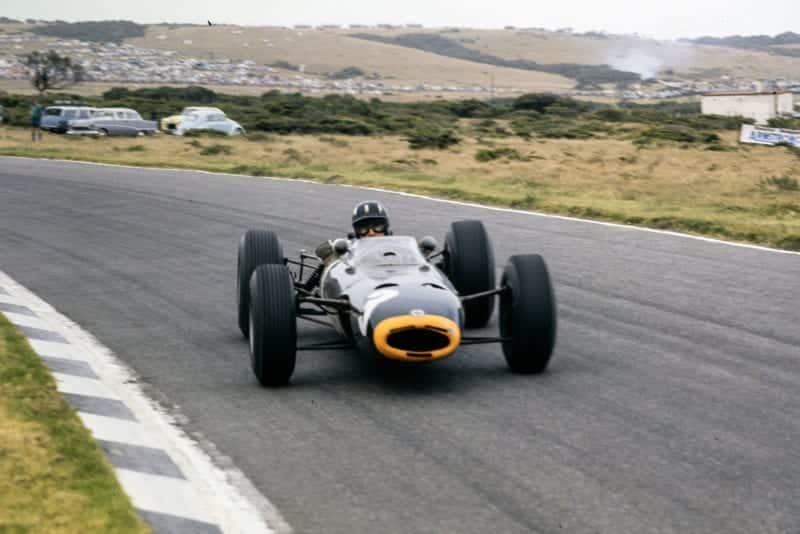
Hill was trying out Goodyear and Dunlop tyres on his BRM before his engine blew-up
Motorsport Images
First practice on Wednesday afternoon was under hot sun, with a fairly strong wind. First out was Stewart going off for the first time in a BRM. Next away was Surtees in the V8 Ferrari, Gurney in his new Brabham on Goodyear tyres and Clark, who was fastest in last year’s practice, with a time of 1min 28.9sec, a speed of 98.63mph (158.696kph). BRM had Goodyear tyres on their spare car, and Hill went out in this while his car was being worked on. He did a number of laps and then brought the car in to have the Goodyear tyres changed to Dunlop yellow-spot. While this was being done he again went out in the new car and as he passed the pits the engine blew up.
Back at the garage it was found that a camshaft had sheared and when the sump dropped, it was found to contain a con-rod. As this was an engine specifically flown out for the car it did not do very well. When the spare car was finally fitted with Dunlop tyres, Hill did another series of laps when he proved to himself and BRM’s that the R6 yellow-spot was 1 second a lap faster over a 90sec lap and with the introduction of the R7 tread there would again be another improvement. This was the first time any team had tested the two tyres on the same car, on the same day, under identical conditions.
Spence was beginning to get his times down when he started to have difficulty with the hairpin and three times in a very few laps he spun. Jack Brabham was out late as he decided to have the Goodyear tyres off and put on Dunlop, which held up his start. Also late due to having tyres changed was Bonnier’s Brabharn-Climax. Both Surtees and Clark were under 1min 30sec within the first hour.
Surtees with 1min 28.6sec and Clark with 1min 28.3sec. The organisers had forecast through the press that there would be a 100-mile per hour lap which meant a time of 1min 27.6sec. The flat-twelve Ferrari which arrived only on the morning of practice had the six pipes per side going into one, which created an exhaust note that was most painful to the ears, but as it was changed back to six into two by the next day, it obviously didn’t improve the performance.
Clark’s times were getting faster and it wasn’t long before he was under 1min 28sec at which stage it was noted that his tell-tale was around 12,000 revs, each time but this didn’t indicate a new engine—only a faulty rev-counter. Brabham came to a halt just beyond the pits when he had transistor trouble, but he was out again in a very short time.
Siffert and Maggs were both in whilst their gear ratios were changed, and the latter was practising on green-spot tyres for this session, to be changed to yellow-spots for the second practice. The Cooper team were having some troubles; Rindt’s gear ratios were not right and McLaren had broken his rear shock-absorbers, although he had satisfied himself that the wider track on the front helped with the car’s handling.
Also in trouble was Anderson, who had a series of small things go wrong with the car, including the starter motor packing up. Clark had a final go with his Lotus and set a time of 1min 27.6sec which was just over the 100-mile an hour the organisers were hoping for. The tail-enders were thrashing around, some slower than others, and were baulking to a certain extent the faster cars.
However, the Clerk of the Course had words with some of the offenders and things improved. Hawkins and Prophet were fastest on the first day and if they could hold this, it would only let in two South African drivers. Second practice was at 6am the next morning when it was hoped that with the wind having dropped and the cooler air, improved times would result. BRM changed Hill’s broken engine and also the lightweight gearbox was changed to the older, heavier box, as Graham had found the intermediate ratios from this box suited the corners better, which is the reason he was faster in the training car in practice instead of the race car. Maggs had the steering box changed on the Lotus-BRM and he also was on yellow-spot tyres.
First out were McLaren, Siffert, Brabbam, Hawkins and Bonnier, all lined up at the exit to the pit road some minutes before the track was opened for practice. Only Love and Pieterse didn’t turn up at all, but Hawkins was not given a time as he came into the pits after one lap. The cold air gauze in a carburetter had sucked in and got under a valve, which ended his morning’s practice. Clark got in 1min 30sec in four laps and in nine laps was down to 1min 28.5sec. The flat-twelve Ferrari had 550 front tyres, while the V8 was on the usual 600’s.
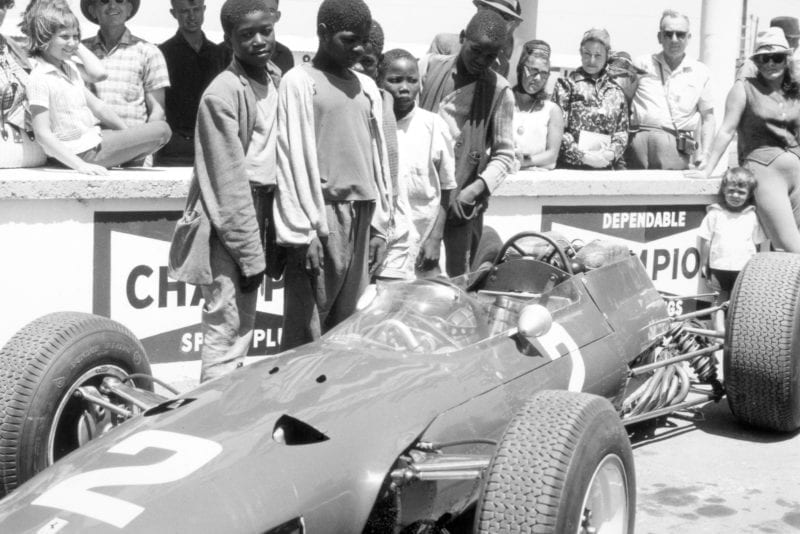
Local children inspect Bandini’s Ferrari
Motorsport Images
Rindt’s Cooper was changed to yellow-spot tyres and also his car’s front track was widened as McLaren’s. Siffert was in after only a few laps and replaced the high-pressure fuel pump. Hill came in with oil all over his gearbox but this, fortunately, only came from the catch tank overflowing. Stewart came into the pits after a short time with misfiring and then the car refused to start. The mechanics thought this was something serious and lifted a cam cover to see if another camshaft had gone but it hadn’t, and when eventually they did discover what was wrong, it turned out to be nothing more serious than a badly seated water cap which at speed sprayed the engine with water and four of the plug leads were shorting.
“Clark was very nearly clobbered by a local driver who lost it at the hairpin and came back onto the track still out of control”
Clark went out for a short practice in which every flying lap was a 1min 27 point something, the quickest being 1min 27.2sec, a speed of 161.8.15kph. During these laps he was very nearly clobbered by a local driver who lost it at the hairpin and came back onto the track still out of control.
Jack Brabham was going very well and he recorded a time of 1min 28.3sec before he changed to Goodyear tyres for a few laps, which didn’t prove anything as the tyres were unscrubbed and he did very few laps before practice ended. Team-mate Gurney was persevering with his tyres although it was becoming obvious his times were suffering from this, also before practice ended, his engine went sick and it was decided to change this before the afternoon practice.
Bandini suddenly slowed past the pits, then reversed back to his pit. Something was not quite right with the fuel feed but the mechanics soon rectified the trouble. Anderson seemed to have sorted out his problems and was going quite well. Practice finished at 8am and was due to start again at 2pm which only gave six hours in which to work. BRM decided to change Stewart’s gearbox to the old box on the spare car as the intermediate ratios were better for East London. However, when the mechanics had the gearbox off they found that the clutch was broken and so the car was not ready for the start of the afternoon’s practice.
This last session had very bad weather, not rain, but wind. The wind blew in gale force all the afternoon making driving or even watching, very difficult. Cars went out reluctantly and even then not for many laps. Both BRMs improved on their previous times. Clark did a few laps towards the end of practice and was 0.1sec faster than any other car, so keeping the record right by setting the fastest lap in each practice. Gurney appeared near the end of practice with his changed engine and improved his time slightly but he was still just over one second slower than Brabham which is the amount BRM proved the tyres would lose. Spence did two laps only to check whether all was well, which is why he has no time in the practice table.
Serrurier, Pieterse, Lederle, Nieman, Blokdyke were the slowest over the three practices and therefore were out of the race on New Year’s Day.
Race
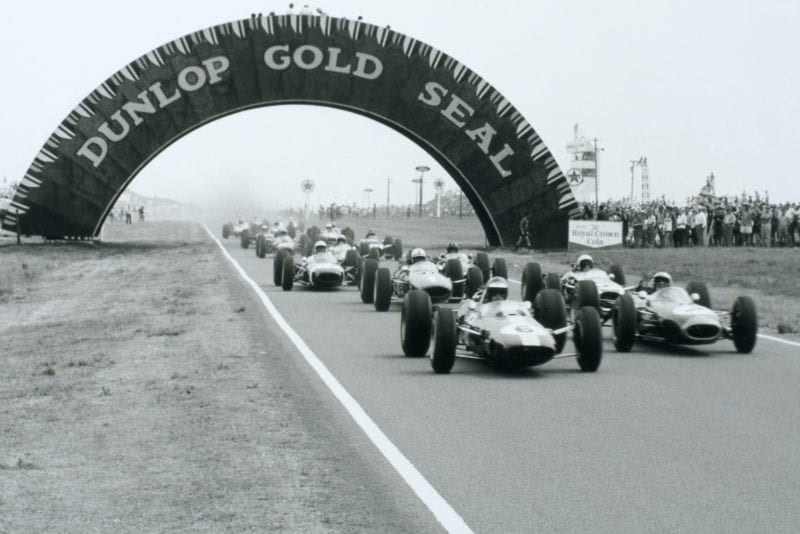
Jim Clark leads the field at the start.
Motorsport Images
Race day was calmer, high and overcast, but still very bright, and the road was dry. After some preliminary races for the South African Clubmen the cars were brought out on to the dummy grid. Lotus had found so little to do in the way of pre-race preparation that after only two hours the night before the cars were ready. Brabham were still on different tyres and Gurney had a new steering column, the original one having cracked and another had to be made from steel tubing. With ten minutes to go the cars did a warming-up lap, again forming up on the dummy grid, then with one minute to go they moved forward and at 2:30pm the flag fell.
Clark made his usual brilliant start being a car’s length ahead in the first 100 yards. Spence, who was just behind him on the grid, followed his team leader and as they streamed out of sight these two were in the lead. Back past the pits at the end of lap one Clark and Spence were clear of the next cars and already pulling out a lead.
“Clark made his usual brilliant start being a car’s length ahead in the first 100 yards”
Behind came Brabham, McLaren, Surtees and Hill, then Bonnier, Bandini, Stewart, Anderson, Maggs, Rindt, Gurney (it is a long time since Dan has been this far back), Gardner, Siffert, Hawkins, de Klerk, Love, Prophet, and Tingle last. On the next lap, the two Lotuses pulled out a few more yards while Surtees pushed past McLaren into fourth place and two laps later he was past Brabham into third place.
Further back Maggs moved ahead of Anderson, while Gurney came into the pits after four laps, dropping several places, he had some obscure electrical trouble which the mechanics were unable to trace. After 45 minutes the engine burst into life, but it was short-lived as with only eleven completed laps the fault struck again, and Gurney left the car out on the circuit.
Also in the pits after only a very few laps was Anderson. He stopped on lap 3 for a moment, did one more lap, then came in to change the brake pipe to the rear brakes. This was replaced, the system quickly bled, but to no avail, the braking being very uneven, and although he continued until the end in last place, he spun several times and was obviously not very happy.
By the sixth lap the two Lotuses were well clear of the third man, Surtees, while Brabham and Hill were hanging on to the Ferrari and not letting it get away. Bandini passed Bonnier on lap six and the Walker car slowed right down on the next lap, came into the pits, went out for two more laps, then came in again. The tank strap had broken letting the tank flap loose. This was repaired and Bonnier went out again in 18th place, where he began to move up through the field. Another pit stop at this time was LDS Alfa of Sam Tingle. He came in with low oil pressure which was, however, found to be a faulty gauge, and he continued.
For the next 30 laps the first nine places remained very static. Further back Rindt in 13th place ran into difficulty when a wire broke to the transistor. This was repaired only to break again and finally the car stopped out on the circuit when another wire broke yet again leaving the car without any sparks. John Love who took over 13th place when Rindt stopped, stopped out on the circuit at Cocobana corner with a broken half-shaft, his race having stopped after 20 laps.
Bandini, who was seventh on lap 33 dropped back one place to Stewart, then made a pit stop with electrical trouble. By the time this was partially rectified he was back in 14th place and well out of the running. On lap 34 Bonnier made another pit stop, this time with clutch or gearbox trouble. He continued until lap 42 when he retired finally with the gearbox trouble. The halfway stage was reached with Clark well in the lead. Spence came next, 13sec behind, then 12sec behind him came Surtees, Brabham and Hill, each about 1sec apart.
Next was McLaren who was 20sec behind Hill. These gaps were altered rather suddenly on the next lap when Spence spun on Beacon Bend as he had done three times in practice, which dropped him to only 3sec ahead of Surtees. This had the effect of showing the hare to the hound and the Ferrari driver really put on the pressure to make sure Spence didn’t get away. On lap 44 Anderson came into the pits after spinning on Beacon Bend and stayed in for some time, then continued, although there was not much he could do to his brakes during the race.
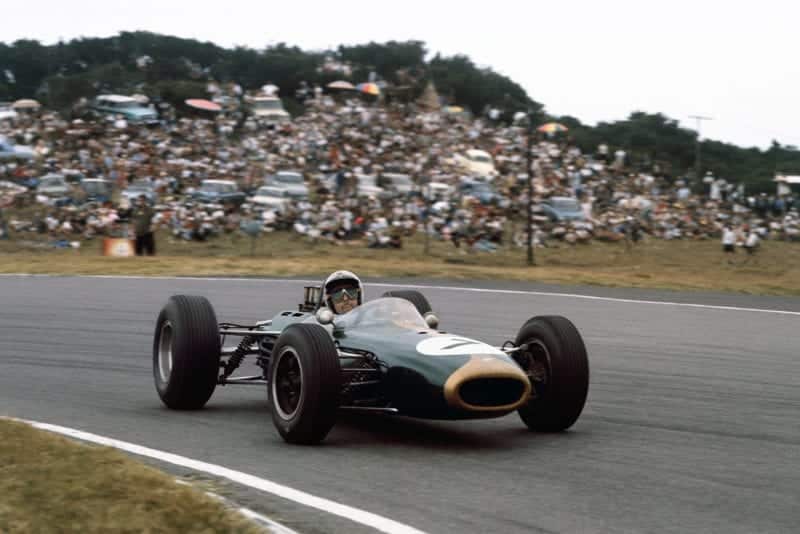
Brabham fell down the order on lap 53 after engine misfire struck
Motorsport Images
The race continued without much position-changing until Brabham’s engine began to misfire and Hill moved up into fourth place on lap 53. Brabham continued for four laps, the misfiring getting worse, then he pulled into the pits on lap 55 when it was found that the rectifier to the alternator was faulty so a new battery was fitted which gave enough power to complete the race. When batteries begin to empty the first thing that suffers is the high pressure fuel pump and as the fuel pressure drops so the engine begins to misfire, which is what had been happening to the Brabham just before it stopped.
About the same lap that Brabham came into the pits Maggs stopped to have his brakes adjusted and went out again. Tingle came in for his second pit-stop, this time for fuel. Then Prophet stopped with oil all over the engine from a burst oil pipe. The mechanics changed this and there was enough oil still in the car to continue. However, the oil was spattered all around Beacons Bend and as Spence was about to complete his 60th lap in second place he again spun on the same bend whereby Surtees passed him on one side and Hill on the other and this change in order lasted until the end.
“The man with the chequered flag, who was obviously not very experienced, suddenly stepped forward and flagged Clark one lap from the end”
On lap 60 Gardner came into the pits with the belt which drives the alternator broken so instead of replacing it he merely had a new battery inserted, which lasted him until the end. On lap 67 the flat-twelve Ferrari finally gave up and was pushed away with an electrical fault, and except for Brabham passing Hawkins just before the end, there was no more drama from a racing point of view.
However, the end of the race proved quite interesting. The man with the chequered flag, who was obviously not very experienced, suddenly stepped forward and flagged Clark one lap from the end. The Lotus driver had just received a pit signal telling him there was one more lap to go, and he therefore waved his arm furiously at the flagman to indicate that he was wrong. A short “conflab” among the senior officials and no-one else was flagged. Clark completed the lap at speed but slowed at his pit for instructions when Chapman beckoned him on to take the chequered flag for the second time.
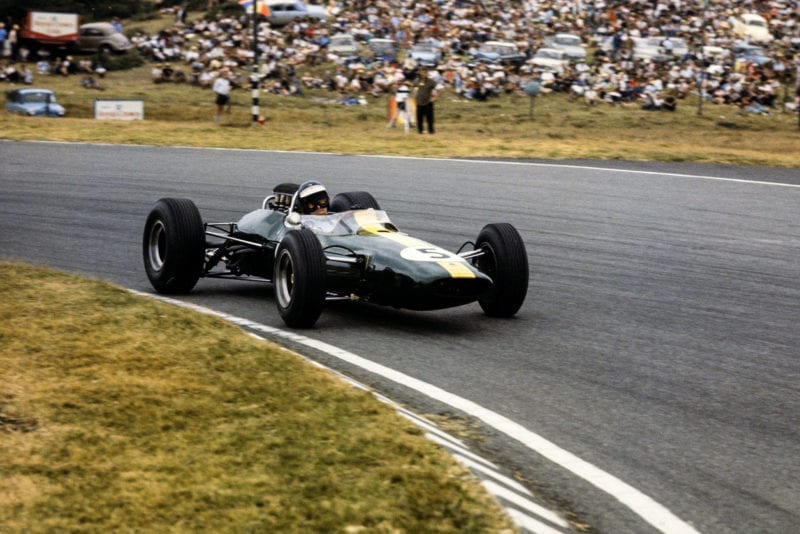
Clark survived some last-lap confusion from the chequered flag waiver toClark survived some last-lap confusion from the chequered flag waiver to take the win
Motorsport Images
Fortunately, Clark was so far ahead of the next man that there was no chance of him being caught due to slowing, but if he had been caught the officials would have had to sort out a pretty mess. Surtees and Hill crossed the line about 30sec, behind with Spence the only other driver not to be lapped 20sec behind them. McLaren finished one lap down and Stewart gained one point in his first Grande Epreuve and his first drive for BRM. The young Scot is to be congratulated on completing an intelligent first outing and these should not be the only points he will gather this year.
A disappointing race in some ways—Clark was much too fast for the opposition. Gurney never really showed off the paces of the Goodyear tyres on to which he has attached his hopes for 1965. The crowd once again didn’t see a classically fought race and this year there were no mechanical failures to increase the excitement.
The next race here on January 1st, 1966 will be the first of the new Formula. This will be a very interesting race from all points of view, so long as the FIA do nothing foolish and remove it from the Championship table because they feel no cars will be ready. The first cars will be ready before the end of this year, and what better date to start the season than the 1st January?
